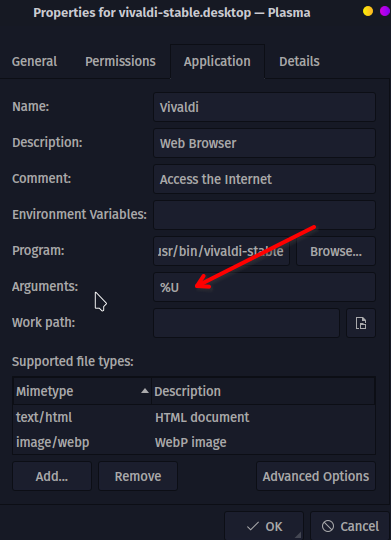Clicking a link in an email gives "your file could not be accessed" error
-
I was having problems accessing website a few days ago, and I was advised by the website owner to clear my browser history. I did this, but the website still didn't work properly. I've given up on it now so that is no longer a problem.
However I have found that now, if I click a link in an email, I get a screen withYour file couldn’t be accessed It may have been moved, edited, or deleted. ERR_FILE_NOT_FOUNDin the address bar there is
file:///home/ian/.cache/kioexec/krun/27917_0/unnamedIf I copy the address from the email and paste it into the browser, it works fine.
All that was ten minutes ago. Now, it's different. Now, when I click the link, the website is loaded into the browser, apparently from a cached copy it's got from here
file:///home/ian/.cache/kioexec/krun/3166_0/unnamed. But, it's displayed as text, not rendered. So it looks like this.<!doctype html> <html lang="en"> <head> <meta name="csrf-param" content="authenticity_token"> <meta name="csrf-token" content="xxxxxxxxxxxxxxxxxxxxxxxxxx"> <title> Level up Your Guitar Playing! </title> <meta charset="utf-8" /> <meta http-equiv="x-ua-compatible" content="ie=edge, chrome=1"> <meta name="viewport" content="width=device-width, initial-scale=1, shrink-to-fit=no"> <meta name="description" content="Zombie Guitar is the #1 "Guitar Theory" site on the web. Learn to improvise, compose, learn songs by ear. Learn to TRULY UNDERSTAND how music works and how it applies to the fretboard!" /> <meta property="og:type" content="website"> <meta property="og:url" content="https://www.zombieguitar.com/login"> <meta name="twitter:card" content="summary_large_image"> <meta property="og:title" content="Level up Your Guitar Playing!"> <meta name="twitter:title" content="Level up Your Guitar Playing!"> <meta property="og:description" content="Zombie Guitar is the #1 "Guitar Theory" site on the web. Learn to improvise, compose, learn songs by ear. Learn to TRULY UNDERSTAND how music works and how it applies to the fretboard!"> <meta name="twitter:description" content="Zombie Guitar is the #1 "Guitar Theory" site on the web. Learn to improvise, compose, learn songs by ear. Learn to TRULY UNDERSTAND how music works and how it applies to the fretboard!"> <meta property="og:image" content="https://kajabi-storefronts-production.kajabi-cdn.com/kajabi-storefronts-production/sites/2147529220/images/2IjdnXPFTg2sjaQTKCJz_file.jpg"> <meta name="twitter:image" content="https://kajabi-storefronts-production.kajabi-cdn.com/kajabi-storefronts-production/sites/2147529220/images/2IjdnXPFTg2sjaQTKCJz_file.jpg">I tried deleting the history cache again, for all time, but the result is the same when I click on the link in the email.
I tried rebooting the system, but still the same thing happened.
I am using OpenSuse Tumbleweed, and the flatpak version of Vivaldi. So installed the package (RPM) version, and that seems to work fine. It looks like it is only the flatpak version that is doing this.
I removed the flatpak version and reinstalled it (from flathub) but the problem is still occurring.What have I done? And how do I rectify it?
Thanks.
-
@mogplus8 Please report issue to Vivaldi bug tracker. Once that is done, share the bug number (beginning with VB-) you got by bug report mail. Thanks for helping us making Vivaldi better.
Can you view the source of the mail, copy it, paste into a text file and add to report so Vivaldi devs can investigate? -
Hey, I was having the same problem after adding adding some custom arguments on vivaldi, so this may help you.
This instructions are for vivaldi stable, will work for snapshots but names may vary a little
Most distros have a way to edit the .desktop files of applications, the way to make vivaldi open links is making sure %U is added as an argument on vivaldi .desktop file, below I'll explain the way to do it on KDE and also how to manually edit the file in case there's no way to do it in your preferred distribution.
KDE specific instructions:
For kde is as easy as typing vivaldi on the application launcher, then right click on vivaldi icon and then edit application go to the Application tab and make sure that there's
%Uinside the arguments field as this pic:
Click OK and you're done.
Manual Should work on most distros:
-
Go to
/home/$USER/.local/share/applications/and check if there's a file calledvivaldi-stable.desktop(the name may vary if you are using an snapshot) if the file exists go to step 3. -
If the file does not exists copy it from
/usr/share/applicationsto/home/$USER/.local/share/applications/ -
Edit the
vivaldi-stable.desktopfile with your file editor of choice.
inside the file there should be variousExec=entries (3 at the moment when I created this post).One for
[Desktop Entry]one for[Desktop Action new-window]and the last one for[Desktop Action new-private-window]you will see those blocks followed by the name on different languages and finally the exec line. you will only need to edit the exec for the[Desktop Entry]probably you will only need to add the%Uat the end in my case it look like this:Exec=/usr/bin/vivaldi-stable %Usave the file and you're done.
Extra (How to add custom arguments to vivaldi STABLE):
If you want to add custom arguments to vivaldi that will work not only when launching vivaldi normally but also when opening it clicking an external link the best way is to navigate to your
$HOME/.configand create a file calledvivaldi-stable.conf(if it doesn't exists already), inside this file you can add whatever arguments you like.
This is an example of mine:--enable-blink-features=MiddleClickAutoscrollPS. If someone need further instructions/help I'll try to keep an eye here for replies.
-
-
This post is deleted! -
@anafletcher88 I don't even know what's that tool, or if it's related to this issue.
-
This post is deleted!
